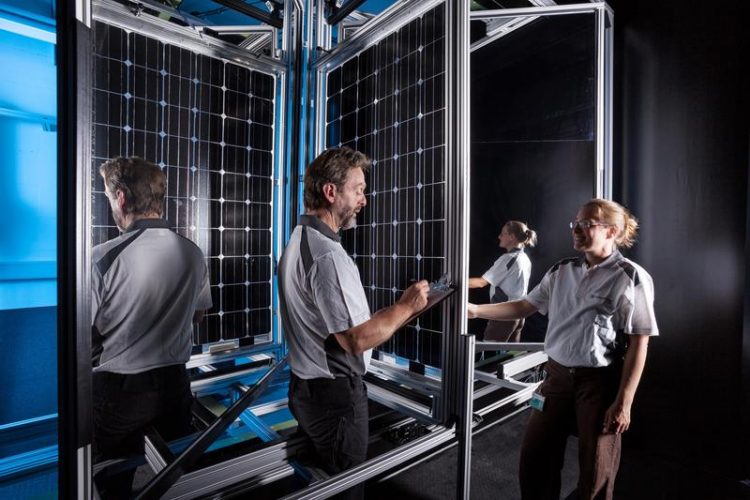Fraunhofer ISE’s CalLab PV Modules Improves Measurement Uncertainty to Record Value of 1.1 %

Employees of CalLab PV Modules use a self-developed solar simulator to measure a bifacial module that generates electricity on both the front and rear surfaces. Picture: Fraunhofer ISE
Measurement uncertainty is a decisive factor for both quality assurance in module production and for investments in PV power plants. Module manufacturers who guarantee a sold power of their products can reduce the tolerances in their data sheet specifications by using more precisely calibrated reference modules.
This involves considerable output and costs, given production volumes on a gigawatt scale. Investors also benefit from reduced measurement uncertainties in module characterization, since simulations of PV power plant yields and thus the calculation of returns becomes more accurate.
“With a global module production of around 100 GW, one percent measurement uncertainty corresponds to one gigawatt of output uncertainty. At today's prices this amounts to around €300 million. High precision pays off for both suppliers and customers,” explains Dr. Harry Wirth, division director for Photovoltaic Modules and Power Plants at Fraunhofer ISE.
During re-accreditation of the calibration laboratory, according to the new DIN EN ISO/IEC 17025:2018 standard with its significantly stricter requirements for laboratories, CalLab PV Modules was able to demonstrate that it has reduced its measurement uncertainty from 1.3 to 1.1 percent for monofacial photovoltaic modules.
Calibrations and Accurate Performance Tests with High Module Throughput
“A great advantage of our calibration laboratory is the combination of highly precise measurements with the capacities for processing large quantities. We are able to measure 5000 modules per year while keeping processing times short,” explains Frank Neuberger, head of CalLab PV Modules.
The laboratory's four simulators can meet different requirements depending on the module technology. As one of the first accredited calibration and testing laboratories in the world, CalLab PV Modules has a self-developed test stand for the calibration of bifacial modules; the measurement uncertainty for this technology has now been reduced from 2.5 to 1.8 percent.
In addition to calibration under standard test conditions (STC), comprehensive performance tests are carried out in the calibration laboratory, especially under low irradiation, different temperatures and angles of incident light.
Based on accurate power rating measurements in accordance with IEC 61853, the experts at Fraunhofer ISE create yield simulations. These are used to very accurately compare different module types for defined locations.
“By optimizing the solar simulator for these measurements, the accuracy could be further improved, especially for low light intensities. As a result, we have significantly reduced the uncertainty in PV yield simulations,” explains Frank Neuberger. Furthermore, CalLab PV Modules supports investors of PV power plants with individual test procedures, in the selection of suppliers and with quality assurance in purchasing.
Fraunhofer ISE's CalLab PV Modules has not only passed re-accreditation according to the new DIN EN ISO/IEC 17025:2018 standard, but also regularly faces comparison with the best calibration laboratories in the world. Currently, CalLab PV Modules is participating in a round robin, in which measurements with the world's leading institutions NREL (USA), JRC (Italy) and AIST (Japan) are compared.
Frank Neuberger, Head of CalLab PV Modules
frank.neuberger@ise.fraunhofer.de
Media Contact
More Information:
https://www.ise.fraunhofer.de/All latest news from the category: Power and Electrical Engineering
This topic covers issues related to energy generation, conversion, transportation and consumption and how the industry is addressing the challenge of energy efficiency in general.
innovations-report provides in-depth and informative reports and articles on subjects ranging from wind energy, fuel cell technology, solar energy, geothermal energy, petroleum, gas, nuclear engineering, alternative energy and energy efficiency to fusion, hydrogen and superconductor technologies.
Newest articles

How marine worms regenerate lost body parts
The return of cells to a stem cell-like state as the key to regeneration. Many living organisms are able to regenerate damaged or lost tissue, but why some are particularly…

Nano-scale molecular detective
New on-chip device uses exotic light rays in 2D material to detect molecules. Researchers have developed a highly sensitive detector for identifying molecules via their infrared vibrational “fingerprint”. Published in Nature…

Novel CAR T-cell therapy
… demonstrates efficacy and safety in preclinical models of HER2-positive solid tumors. The p95HER2 protein is found expressed in one third of HER2+ tumors, which represent 4% of all tumors….



